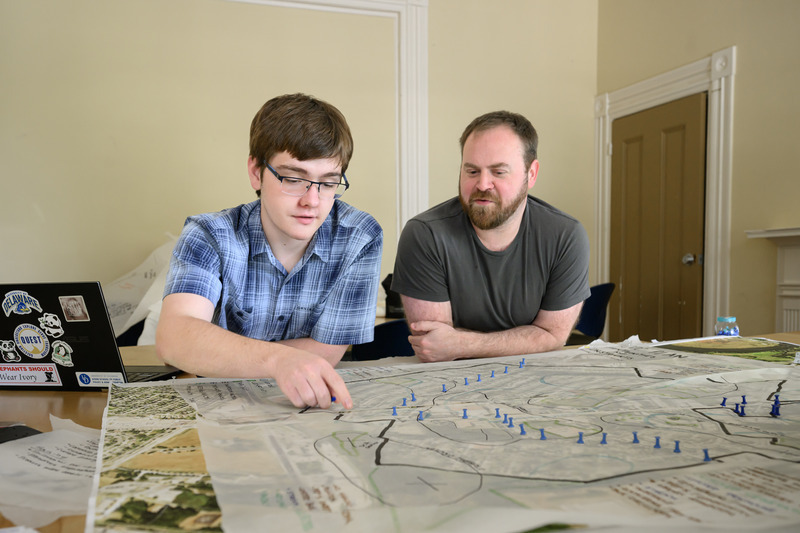


Boosting nature’s benefits on communities
Photo by Kathy F. Atkinson August 22, 2025
UD student Matthew Willmes works on Route 9 community resilience plan
Editor’s note: Every year, hundreds of undergraduates at the University of Delaware pursue research under the guidance of a faculty mentor, especially during the summer months. Such experiences provided by UD — a nationally recognized research university — can be life-changing, introducing young scholars to a new field, perhaps even the path to a future career, as they uncover new knowledge. These spotlights offer a glimpse into their world.
In northern Delaware, a dozen communities along Route 9 are working together to become healthier and stronger — with Mother Nature as a powerful force for change.
Numerous studies have shown that a healthy natural environment plays a key role in supporting our physical and mental well-being. Spending time outdoors, connected with nature, has been linked to stronger immune function, lower blood pressure, and reduced levels of stress and depression.
Parks and other green spaces also can help prevent “urban heat islands,” a phenomenon where cities become significantly warmer than surrounding rural areas due to the concentration of heat-absorbing surfaces like concrete and asphalt from buildings and roads. Additionally, wetlands act as storm buffers, absorbing excess floodwater and gradually releasing it, helping to prevent flood damage.
Matthew Willmes, a University of Delaware junior and Climate Scholar majoring in energy and environmental policy from Springfield, Virginia, is part of a team from UD’s Coastal Resilience Design Studio that is working with the Route 9 Community Development Corporation (CDC) to create a community resilience plan that includes such aspects as greater greening and stormwater management. His adviser is Zachery Hammaker, assistant professor of landscape architecture in UD’s Department of Plant and Soil Sciences.
Q: What attracted you to this project?
Willmes: I wanted to pursue this research opportunity because it would give me the chance to work on a real-life problem and create tangible, impactful solutions. Working with the Coastal Resilience Design Studio aligned with my interests in community-focused research and environmental policy, while also allowing me to interact with various stakeholders within the Route 9 CDC. This was important to me because stakeholder engagement is an essential skill in my aspirations to become an environmental policymaker.
Q: Why does research like this matter?
Willmes: Research like this is important because it directly supports communities that have historically been excluded from planning and investment decisions. In places like the Route 9 CDC, decades of land use decisions have prioritized industry and transportation over the people living there. Research like this matters because it gives those communities more control over their lives, and it empowers them to right those historic wrongs.
Q: What does your daily research entail?
Willmes: My daily research primarily involves examining geodatabases, which serve as containers for geographic data and the rules governing their use, access and management. I then perform GIS analysis, utilizing that geographic data to identify patterns related to environmental and community concerns. This includes tracking heat exposure in neighborhoods, mapping tree cover, or pinpointing heavily polluted areas. GIS, or Geographic Information Systems, transform complex data into visual tools that aid in informed decision-making and planning. For example, my most recent GIS analysis involved creating maps for impervious surfaces and tree canopy cover and then overlaying them to identify areas that may be vulnerable to the urban heat island effect. Additionally, as the policy-oriented major on the team, I review comprehensive plans and zoning ordinances and have interviewed a WILMAPCO project manager about their involvement in the Route 9 master land use and transportation plan.
Q: What’s the coolest thing about being involved in this project?
Willmes: The coolest thing about being involved in this project is being able to work with an interdisciplinary team of students who share similar interests. On the team, we have three landscape architecture students and one environmental engineer. Gaining a glimpse into their worlds has been fascinating. For example, when we were finishing our maps, we listened to a lecture by one of the professional landscape architects on color theory and the hidden meanings behind specific colors.
Q: Is there anything you've discovered about yourself and your career goals as you've worked on the project?
Willmes: I’ve discovered that I still have much to learn and that the information taught in my courses actually can be applied to real-life problems. I’ve learned that, while it's useful to specialize, my ability to touch upon a variety of topics helps me maintain a comprehensive view of our project. As for my career goals, I’ve learned that policymakers cannot be too far removed from local issues, and that I am interested in pursuing local environmental policy, rather than federal environmental policy, which is what I previously thought I’d be interested in.
Q: What do you enjoy doing in your spare time?
Willmes: I enjoy spending time with family and friends, playing strategic board games and watching movies.
Contact Us
Have a UDaily story idea?
Contact us at ocm@udel.edu
Members of the press
Contact us at mediarelations@udel.edu or visit the Media Relations website

